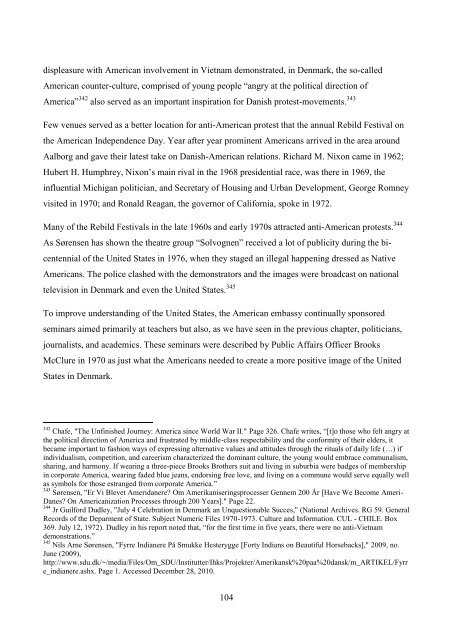The Jeremiad Over Journalism
The Jeremiad Over Journalism
The Jeremiad Over Journalism
You also want an ePaper? Increase the reach of your titles
YUMPU automatically turns print PDFs into web optimized ePapers that Google loves.
displeasure with American involvement in Vietnam demonstrated, in Denmark, the so-called<br />
American counter-culture, comprised of young people ―angry at the political direction of<br />
America‖ 342 also served as an important inspiration for Danish protest-movements. 343<br />
Few venues served as a better location for anti-American protest that the annual Rebild Festival on<br />
the American Independence Day. Year after year prominent Americans arrived in the area around<br />
Aalborg and gave their latest take on Danish-American relations. Richard M. Nixon came in 1962;<br />
Hubert H. Humphrey, Nixon‘s main rival in the 1968 presidential race, was there in 1969, the<br />
influential Michigan politician, and Secretary of Housing and Urban Development, George Romney<br />
visited in 1970; and Ronald Reagan, the governor of California, spoke in 1972.<br />
Many of the Rebild Festivals in the late 1960s and early 1970s attracted anti-American protests. 344<br />
As Sørensen has shown the theatre group ―Solvognen‖ received a lot of publicity during the bi-<br />
centennial of the United States in 1976, when they staged an illegal happening dressed as Native<br />
Americans. <strong>The</strong> police clashed with the demonstrators and the images were broadcast on national<br />
television in Denmark and even the United States. 345<br />
To improve understanding of the United States, the American embassy continually sponsored<br />
seminars aimed primarily at teachers but also, as we have seen in the previous chapter, politicians,<br />
journalists, and academics. <strong>The</strong>se seminars were described by Public Affairs Officer Brooks<br />
McClure in 1970 as just what the Americans needed to create a more positive image of the United<br />
States in Denmark.<br />
342<br />
Chafe, "<strong>The</strong> Unfinished Journey: America since World War II." Page 326. Chafe writes, ―[t]o those who felt angry at<br />
the political direction of America and frustrated by middle-class respectability and the conformity of their elders, it<br />
became important to fashion ways of expressing alternative values and attitudes through the rituals of daily life (…) if<br />
individualism, competition, and careerism characterized the dominant culture, the young would embrace communalism,<br />
sharing, and harmony. If wearing a three-piece Brooks Brothers suit and living in suburbia were badges of membership<br />
in corporate America, wearing faded blue jeans, endorsing free love, and living on a commune would serve equally well<br />
as symbols for those estranged from corporate America.‖<br />
343<br />
Sørensen, "Er Vi Blevet Ameridanere? Om Amerikaniseringsprocesser Gennem 200 År [Have We Become Ameri-<br />
Danes? On Americanization Processes through 200 Years]." Page 22.<br />
344<br />
Jr Guilford Dudley, "July 4 Celebration in Denmark an Unquestionable Succes," (National Archives. RG 59. General<br />
Records of the Deparment of State. Subject Numeric Files 1970-1973. Culture and Information. CUL - CHILE. Box<br />
369. July 12, 1972). Dudley in his report noted that, ―for the first time in five years, there were no anti-Vietnam<br />
demonstrations.‖<br />
345<br />
Nils Arne Sørensen, "Fyrre Indianere På Smukke Hesterygge [Forty Indians on Beautiful Horsebacks]," 2009, no.<br />
June (2009),<br />
http://www.sdu.dk/~/media/Files/Om_SDU/Institutter/Ihks/Projekter/Amerikansk%20paa%20dansk/m_ARTIKEL/Fyrr<br />
e_indianere.ashx. Page 1. Accessed December 28, 2010.<br />
104
















